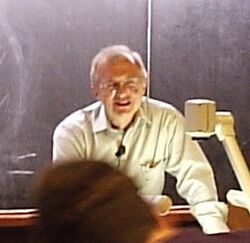Friedlander–Iwaniec theorem
In analytic number theory the Friedlander–Iwaniec theorem states that there are infinitely many prime numbers of the form [math]\displaystyle{ a^2 + b^4 }[/math]. The first few such primes are
- 2, 5, 17, 37, 41, 97, 101, 137, 181, 197, 241, 257, 277, 281, 337, 401, 457, 577, 617, 641, 661, 677, 757, 769, 821, 857, 881, 977, … (sequence A028916 in the OEIS).
The difficulty in this statement lies in the very sparse nature of this sequence: the number of integers of the form [math]\displaystyle{ a^2+b^4 }[/math] less than [math]\displaystyle{ X }[/math] is roughly of the order [math]\displaystyle{ X^{3/4} }[/math].
History
The theorem was proved in 1997 by John Friedlander and Henryk Iwaniec.[1] Iwaniec was awarded the 2001 Ostrowski Prize in part for his contributions to this work.[2]
Refinements
The theorem was refined by D.R. Heath-Brown and Xiannan Li in 2017.[3] In particular, they proved that the polynomial [math]\displaystyle{ a^2 + b^4 }[/math] represents infinitely many primes when the variable [math]\displaystyle{ b }[/math] is also required to be prime. Namely, if [math]\displaystyle{ f(n) }[/math] is the prime numbers less than [math]\displaystyle{ n }[/math] in the form [math]\displaystyle{ a^2 + b^4, }[/math] then
[math]\displaystyle{ f(n) \sim v \frac{x^{3/4}}{\log{x}} }[/math]
where
[math]\displaystyle{ v=2 \sqrt{\pi} \frac{\Gamma(5/4)}{\Gamma(7/4)} \prod_{p \equiv 1\bmod 4} \frac{p-2}{p-1} \prod_{p \equiv 3\bmod 4} \frac{p}{p-1}. }[/math]
Special case
When b = 1, the Friedlander–Iwaniec primes have the form [math]\displaystyle{ a^2+1 }[/math], forming the set
- 2, 5, 17, 37, 101, 197, 257, 401, 577, 677, 1297, 1601, 2917, 3137, 4357, 5477, 7057, 8101, 8837, 12101, 13457, 14401, 15377, … (sequence A002496 in the OEIS).
It is conjectured (one of Landau's problems) that this set is infinite. However, this is not implied by the Friedlander–Iwaniec theorem.
References
- ↑ Friedlander, John; Iwaniec, Henryk (1997), "Using a parity-sensitive sieve to count prime values of a polynomial", PNAS 94 (4): 1054–1058, doi:10.1073/pnas.94.4.1054, PMID 11038598.
- ↑ "Iwaniec, Sarnak, and Taylor Receive Ostrowski Prize"
- ↑ Heath-Brown, D.R.; Li, Xiannan (2017), "Prime values of [math]\displaystyle{ a^2 + p^4 }[/math]", Inventiones Mathematicae 208: 441-499, doi:10.1007/s00222-016-0694-0.
Further reading
- Cipra, Barry Arthur (1998), "Sieving Prime Numbers From Thin Ore", Science 279 (5347): 31, doi:10.1126/science.279.5347.31.
 |



